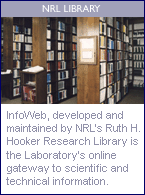| AWARDS & RECOGNITIONS |
| TIME LINE |
| SYSTEMS |
| ROCKETS |
| SOLAR & LUNAR STUDIES |
| ASTRONOMY |
| OCEAN & ENVIRONMENT |
| MATERIALS |
| DIRECTORATES & DIVISIONS |
| NANOSCIENCE INSTITUTE |
| NRL REVIEW |
| FUTURE NAVAL CAPABILITIES |
| NRL RESEARCH LIBRARY |
| FACILITIES |
| PROGRAM SPONSORS |
| / NRL / Accomplishments / Rockets | |||||||
| Rockets | |||||||
| Awards & Recognitions Time Line Systems Rockets V-2 Rockets Viking Program Aerobee Rockoon Nike Booster Vanguard Project NavSpaSur Solar & Lunar Studies Astronomy Ocean & Environment Materials |
V-2 Rockets - Both space-based astronomy and the U.S. Navy’s space program were born in the V-2 rocket program. After World War II, the U.S. Army invited scientists to fill the space of the 2000-lb. warhead with instruments. The Rocket Sonde Branch was established in January 1946 and by October, their instrumentation brought back the first solar UV spectrogram. Viking Program - In 1946, NRL developed a new sounding rocket called Viking, and a total of 12 Viking rockets were launched from 1949 to 1954. NRL was first to measure temperature, pressure, and winds in the upper atmosphere and electron density in the ionosphere, and to record the ultraviolet spectra of the Sun.
Rockoon - To study solar flares, which occur suddenly and unpredictably, NRL developed a small, simple rocket which was tied to a 150,000 cubic foot balloon. The balloon carried the rocket to a height of 25 km, where it hovered till fired by radio command at the first sign of a solar flare. Nike Booster - NRL used Nike rockets to study the Sun during the International Geophysical Year (July 1957 to December 1958). During these studies, NRL scientists recorded the first measurements of ultraviolet and X-ray emissions during a solar flare. Vanguard Project - Vanguard was the prototype for much of the U.S. space program. Between 1955 and 1959, NRL conducted the first American satellite program called Vanguard, and on March 17, 1958, the Vanguard I satellite was successfully launched. Vanguard I orbits Earth today as the oldest man-made satellite and will remain in orbit well into the 22nd century. NavSpaSur - NRL developed the Naval Space Surveillance System to detect and track satellites. NavSpaSur became operational in 1961 and remains an active part of the North American Aerospace Defense Command. |

|
||